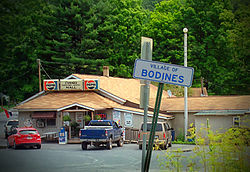Trout Run, Pennsylvania
| Lewis Township, Lycoming County, Pennsylvania |
|
|---|---|
| Township | |

Bodines is a village in the township
|
|
 Map of Lycoming County, Pennsylvania highlighting Lewis Township |
|
 Map of Lycoming County, Pennsylvania= |
|
| Coordinates: 41°24′1″N 77°2′40″W / 41.40028°N 77.04444°WCoordinates: 41°24′1″N 77°2′40″W / 41.40028°N 77.04444°W | |
| Country | United States |
| State | Pennsylvania |
| County | Lycoming |
| Settled | 1812 |
| Incorporated | 1835 |
| Area | |
| • Total | 37.44 sq mi (96.97 km2) |
| • Land | 37.09 sq mi (96.06 km2) |
| • Water | 0.35 sq mi (0.91 km2) |
| Elevation | 1,732 ft (528 m) |
| Population (2010) | |
| • Total | 987 |
| • Estimate (2016) | 965 |
| • Density | 26.02/sq mi (10.05/km2) |
| Time zone | Eastern Time Zone (North America) (UTC-5) |
| • Summer (DST) | EDT (UTC-4) |
| FIPS code | 42-081-42944 |
| GNIS feature ID | 1216753 |
Lewis Township is a township in Lycoming County, Pennsylvania, United States. The population was 1,139 at the 2000 census. It is part of the Williamsport, Pennsylvania Metropolitan Statistical Area.
Lewis Township was formed from part of Hepburn Township in 1835. It is named for Ellis Lewis who was the president judge of the local district court at the time. The township was expanded in on December 10, 1846 when part of Cascade Township was added to Lewis Township. This was done at the request of the residents of the area who geographically cut off from the rest of Cascade Township.
Lycoming Creek and the Sheshequin Path played an important role in the early history of Lewis Township. The path was a major Native American trail in that ran between two Native American villages: "French Margaret's Town" on the West Branch Susquehanna River (part of modern-day Williamsport in Lycoming County) and "Sheshequin" on the North Branch of the Susquehanna River (modern day Ulster Township, in Bradford County). The path ran north and east along Lycoming Creek in Lycoming County and followed much of Towanda Creek in Bradford County. It was a shortcut between the two main branches of the Susquehanna River and was used by early settlers as well as Native Americans.
...
Wikipedia
